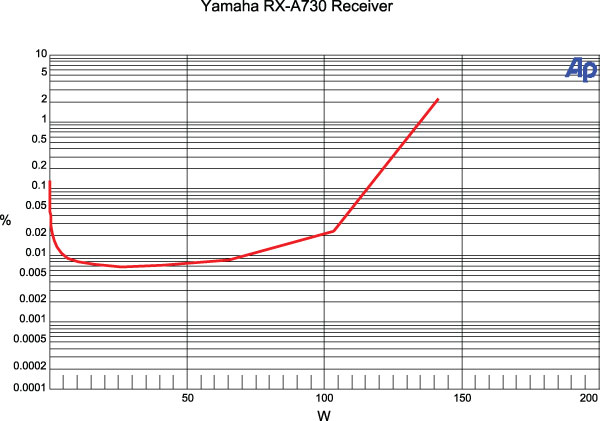Yamaha RX-A730 Network A/V Receiver Test Bench
Two channels driven continuously into 8-ohm loads:
0.1% distortion at 115.5 watts
1% distortion at 134.7 watts
Five channels driven continuously into 8-ohm loads:
0.1% distortion at 32.4 watts
1% distortion at 67.2 watts
Seven channels driven continuously into 8-ohm loads:
0.1% distortion at 27.1 watts
1% distortion at 33.3 watts
Analog frequency response in Pure Direct mode:
–0.11 dB at 10 Hz
–0.03 dB at 20 Hz
+0.09 dB at 20 kHz
–2.47 dB at 50 kHz
Analog frequency response with signal processing:
–0.24 dB at 10 Hz
–0.07 dB at 20 Hz
–0.39 dB at 20 kHz
–61.64 dB at 50 kHz

This graph shows that the RX-A730’s left channel, from Audio1 input to speaker output with two channels driving 8-ohm loads, reaches 0.1 percent distortion at 115.5 watts and 1 percent distortion at 134.7 watts. Into 4 ohms, the amplifier reaches 0.1 percent distortion at 145.1 watts and 1 percent distortion at 183.8 watts.
There was no multichannel input to measure. THD+N from the Audio1 input to the speaker output was less than 0.018 percent at 1 kilohertz when driving 2.83 volts into an 8-ohm load. Crosstalk at 1 kHz driving 2.83 volts into an 8-ohm load was –69.17 decibels left to right and –68.90 dB right to left. The signal-to-noise ratio with an 8-ohm load from 10 hertz to 24 kHz with “A” weighting was –109.21 dBrA.
From the Dolby Digital input to the loudspeaker output, the left channel measures –0.03 dB at 20 Hz and –0.11 dB at 20 kHz. The center channel measures –0.06 dB at 20 Hz and –0.15 dB at 20 kHz, and the left surround channel measures –0.06 dB at 20 Hz and –0.15 dB at 20 kHz. From the Dolby Digital input to the line-level output, the LFE channel is +0.10 dB at 20 Hz when referenced to the level at 40 Hz and reaches the upper 3-dB down point at 96 Hz and the upper 6-dB down point at 116 Hz. —MJP

Video Test Bench
Unfortunately, the Yamaha didn’t fare too well in our HD video processing tests (1080i in to 1080p out), with visible moiré on both the 3:2 HD and 2:2 HD tests. It also failed the 2:2 SD test, although this is a common failure of most video processing solutions and rarely comes into play with real-world material. Furthermore, the Yamaha fails the Chroma Resolution test with the processing engaged, but if the video processing is bypassed it passes the signal unmolested.
—DV
- Log in or register to post comments
























































